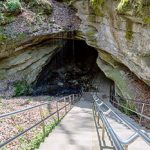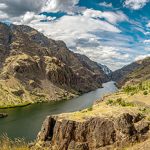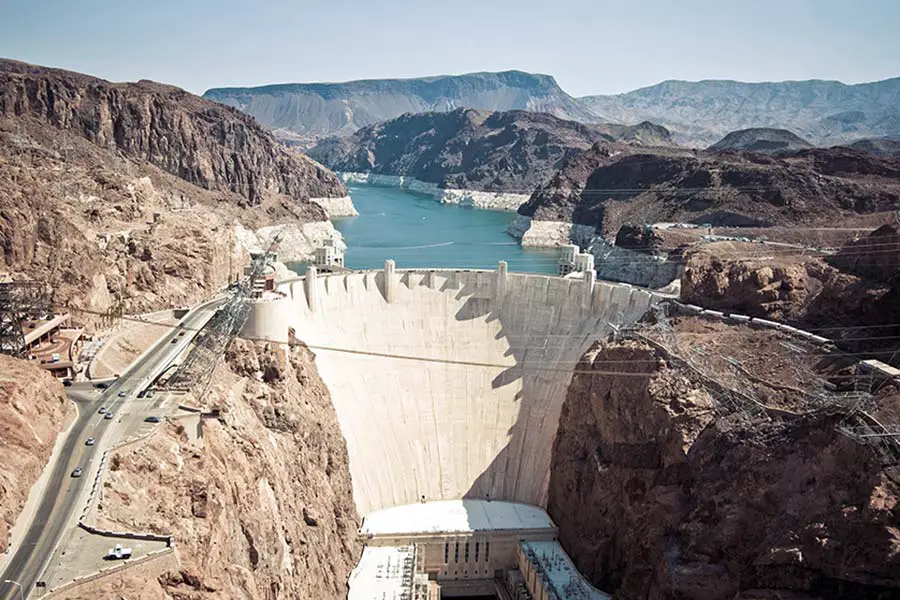
The Hoover Dam is a wonder of engineering. At 726 feet high and 1,244 feet long, the Hoover Dam is an enormous piece of work, and you might be wondering whether you can drive across the Hoover Dam.
You can drive your vehicle across the Hoover Dam, but you must turn around and drive back: there is no through traffic. Visitors can drive from the Nevada side to the Arizona side to see the views, but they must return to Nevada: you cannot enter or exit Hoover Dam on the Arizona side.
So can you walk on the Hoover Dam? Why did they build a bypass bridge? Where does the power from the Hoover Dam go? This post will answer these questions plus a whole lot more.
Hoover Dam: One Big Dam
The Hoover Dam is an arch-gravity dam, sometimes called an arched dam. This kind of structure curves ever so slightly into the upstream side of the dam. This design redirects the water pressure into the canyon walls, which lessens the load on the dam and enables engineers to use less material when building the dam.
That said, the Hoover Dam is massive, and it required a lot of material and manpower to construct. At the time it was built, the Hoover Dam cost $49 million. That works out to about $866 million in current dollars.
The Hoover Dam was built in response to a need for flood control, irrigation, and electricity. By damming the Colorado River, engineers could control flash-flooding, provide viable irrigation water, and generate electricity – neatly solving three problems with one structure.
President Coolidge authorized the dam in December of 1928, and work began in earnest in March of 1931.
The Hoover Dam was a massive project. In total, the dam required more than 6.6 million tons of cement and 45 million pounds of rebar. It also required an enormous labor force, totaling more than 5,000 men; the workers were housed in the nearby town of Boulder City, which was purpose-built to house the workers.
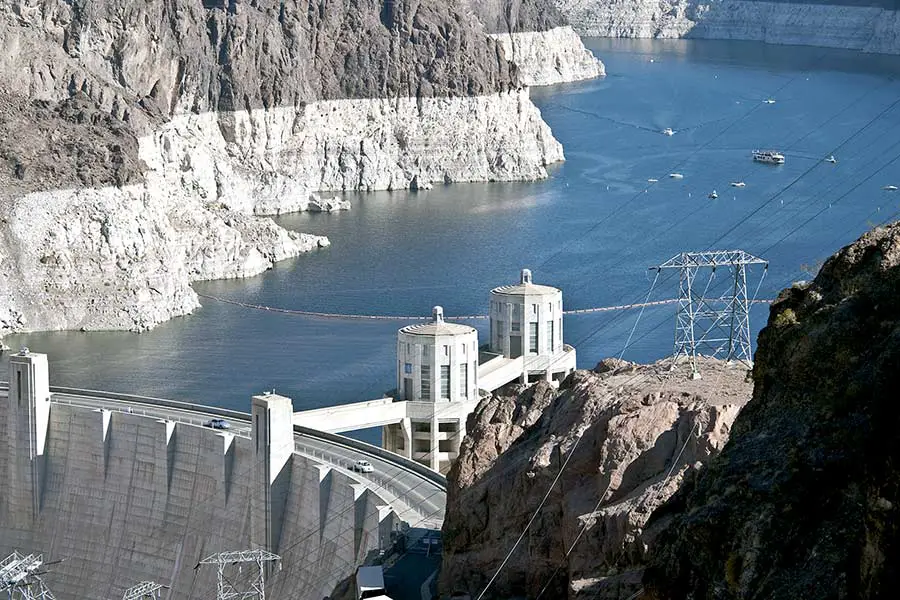
Building the dam was hard work. First, workers had to divert the Colorado River, then build cofferdams to prevent flooding at the worksite. They then had to shape the canyon walls, clearing eroded materials and digging down to the bedrock so the dam could be built on solid ground. This work was dangerous, heavy labor, but the men who did it – known as “high scalers” – became renowned for their skill and bravery.
After diverting the river and clearing the rock, it was time to build the dam. Engineers calculated that doing one enormous concrete pour would have led to structural problems and uneven cooling, so the dam was constructed in blocks. Concrete was poured into the dam in segments from June 1933 to May 1935.
Originally, the Hoover Dam’s roadway was part of US Route 93. However, as time went on and traffic counts ticked up, officials realized that the road over the dam would not be adequate.
After decades of arguing, negotiating, bargaining, and planning, construction on a new bridge began in the early 2000s. In 2010, the Hoover Dam was closed to through traffic, and US Route 93 was rerouted over the new Mike O’Callaghan – Pat Tillman Memorial Bridge.
The road closure on the Hoover Dam prevents through traffic, but motorists can still drive across the dam if they want to. The United States Bureau of Reclamation allows vehicle traffic on the dam.
Motorists will need to access the dam from the Nevada side; then, after a security inspection, vehicles are permitted to drive over the dam. Once on the Arizona side, you can park or enjoy the scenic viewpoints before returning to the Nevada side of the dam.

Fees and Hours
There is no fee to visit the Hoover Dam. There is, however, a $10 fee for parking. You will also have to pay a nominal fee if you want to have a guided tour of the dam or the powerplant. The dam is open from 5 AM to 9 PM every day; tours begin at 9 AM, with the day’s final tour leaving at 4 PM. There are no tours on Christmas or Thanksgiving.
Permitted Vehicles
The following types of vehicles are permitted to drive across the Hoover Dam:
- Passenger cars and light trucks with a cargo capacity of less than one ton
- Vans and SUVs
- Motorcycles
- Dual-wheel trucks
- RVs and Motor Homes
- Semi tractors (“Bob Tails”)
- Busses without luggage
- Camper trailers, trailers with boats and watercraft, fifth-wheels
However, please note that if the security officers at the Hoover Dam feel that your vehicle represents some sort of hazard to the dam, it will not be allowed to pass through the checkpoint.
Road Trip Answers Fun Fact: The Hoover Dam was named after President Herbert Hoover, but Hoover’s most notable contribution to the dam – the negotiation of the Colorado River Compact – happened when Hoover was the Secretary of Commerce.
Other Posts of Interest
- Can You Drive To The Top Of Mount Washington?
- Can You Drive To The Top Of Mauna Kea?
- Can You Drive All The Way Around Crater Lake?
- Can You Drive To The Top Of Pikes Peak?
Hoover Dam Security Measures
Visitors to the Hoover Dam should be aware that there is a Security Zone around the dam. This Security Zone was established after 9/11 to protect the Hoover Dam, which is not just an American icon but also a critical piece of infrastructure.
To enter the Security Zone, motorists must pass through a security checkpoint. All vehicles may be searched at the checkpoint, including in the undercarriage and in any storage compartments. In addition, all RVs, rental trucks, and box trucks will be searched before being allowed in the Security Zone.
If you travel with firearms, pepper spray, mace, or other weaponry, you may not bring it into the Security Zone, even if you intend to keep it locked in your vehicle. In addition, if you refuse to allow your vehicle to be inspected, you and your vehicle will not be permitted to enter the Security Zone.
Drone operators will also be disappointed to learn that no drone flying is allowed on Hoover Dam property. The nearest drone-friendly airspace is in nearby Boulder City.
Can You Walk Across the Hoover Dam?
You can walk across the Hoover Dam from the Nevada side of the bridge. A Pedestrian Plaza inside the dam’s security zone offers access to the sidewalk that crosses the Hoover Dam. The sidewalk has easy access to several spectacular sight-seeing opportunities: there are colossal views of the Colorado River and Lake Mead.
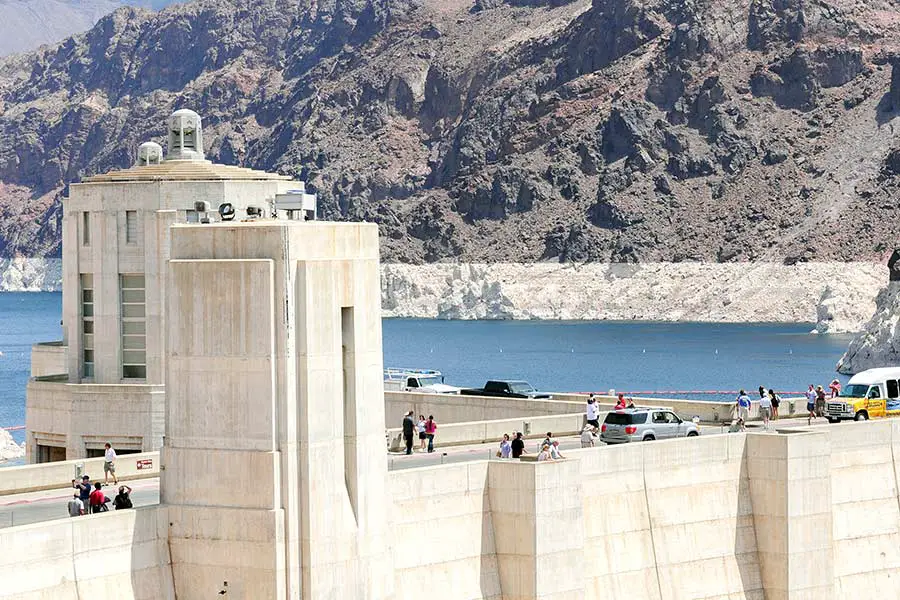
Why was the Hoover Dam Bypass Bridge Built?
In the early 1960s, government officials began to realize that the projected growth of traffic on US 93 – the highway that ran across the top of the Hoover Dam – would soon make the roads dangerously inadequate. As a result, a larger, more modern bridge needed to be constructed to avoid putting undue strain on the Hoover Dam.
The need for an alternate bridge route was solidified after the September 11 terrorist attacks, when officials realized that the Hoover Dam could be vulnerable to nefarious actors.
Commercial trucks and box trucks were banned from the Hoover Dam’s security zone, which was a significant inconvenience for many people.
In 2001, after years of collaboration with local and state officials, the Federal Highway Administration chose the route. Construction began in 2003, and in 2010 the bridge was opened. Today, the Mike O’Callaghan – Pat Tillman Memorial Bridge is the highest concrete arch bridge in the world and the second-highest bridge in the United States.
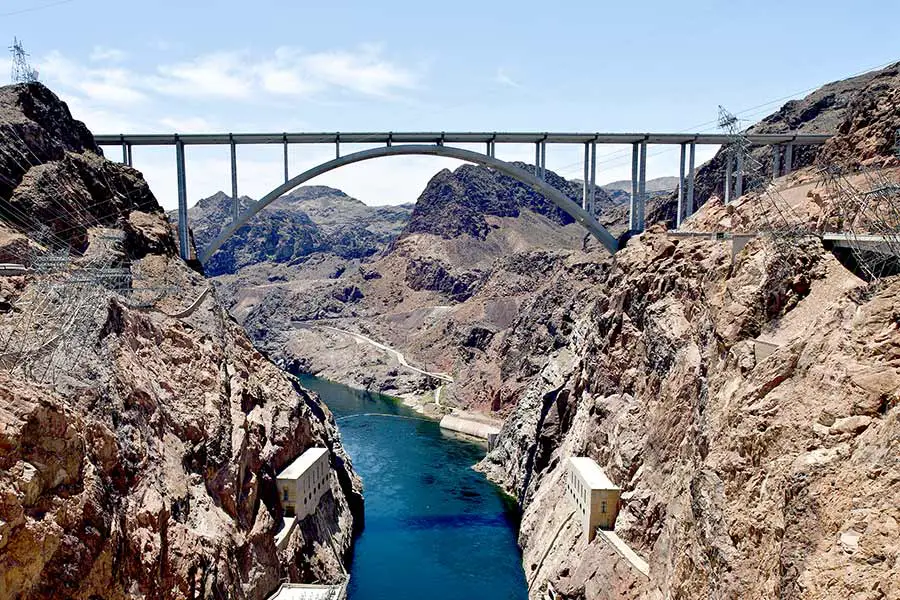
What Type of Bridge is the Hoover Dam Bridge?
The Hoover Dam Bridge, which is also called the Mike O’Callaghan – Pat Tillman Memorial Bridge, is an arch bridge. As the name suggests, this kind of bridge is built on an arch, which distributes the load of the bridge. The arch bridge dates back to at least the ancient Romans, who used arch bridges and arches to construct their elaborate road and water-supply networks.
The bridge is 1,900 feet long, with an 890-foot clearance beneath it. In other words, it is a long way down. Walking across a bridge 890 feet in the air is definitely a memorable experience. However, if heights are not your thing, you may want to consider skipping this one.
Can You Walk Across the Hoover Dam Bridge?
You can walk across the Hoover Dam Bridge. Park at the parking lot for the Mike O’Callaghan-Pat Tillman Memorial Bridge, and head up the stairs or the trail to a plaza with interesting information and plaques. From there, head up to the public walkway, which carries you across the gorge on the Hoover Dam side. Bring your camera, because the view is incredible.
There is no fee to access the pedestrian walkway. It is exposed and unshaded, so bring sun gear and water with you when you go. The total walk from the parking area to the far side of the bridge and back again is about a mile.
The Hoover Dam: A Feat of American Engineering
The Hoover Dam is a callback to classic American grit and ingenuity. Built during the Great Depression as part of FDR’s New Deal, the Hoover Dam literally changed the course of human history by providing fresh water and electricity to residents of the southwestern United States.
Today, the Hoover Dam is just as inspiring as ever, and while it’s no longer an active part of a highway, you can still drive your car across the top. So be sure to stop by and admire the dam on your next road trip across southwest America.



